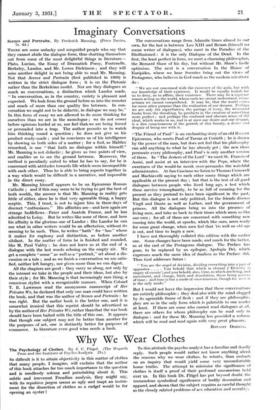Why We Wear Clothes The Psychology of Clothes. By J.
C. Fillip'. (The Hogarth Press and the Institute of Psycho-Analysis. 21s.)
So difficult is it to attain objectivity in this matter of clothes that many people, I imagine, will exclaim that the author of this book attaches far too much importance to the question and is needlessly solemn and painstaking abotit it. This subtle and irreverent Freudian analysis, they might say, with its repulsive jargon seems as ugly and inapt an instru- ment for the dissection of clothes as a cudgel would be for opening an oyster 1
To this attitude the psycho-analyst has a familiar and deadly reply. Such people would rather not know anything about the reasons why we wear clothes, he retorts, than embark on an inquiry that would yield some very uncomfortable home truths. The attempt to minimize the significance -of clothes is itself a proof of their profound unconscious hold over us. In this book Dr. Flugel. has put beyond doubt the tremendous symbolical significance of bodily decoration and apparel, and shown that the subject requires as careful thought as the closely related problems of sex education and morality. It is not so much that clothes make the man as that they stand for him. They are like writing on his body, explaining
what he is, for all the world to decipher if it has the key.
If this book is as popular as it deserves to be, we shall all be able to read this language. We shall no longer be deceived by others or by our own unconscious motives. We shall make clothes our servants, not tolerate them as our masters. We may even dispense with servants altogether, in the new labour-saving house of the free mind ! It is an attractive picture.
Dr. Filigel observes that clothing serves three purposes : protection, decoration and modesty. He is not deceived; as, indeed, few of us are, into regarding the first as important.
The anthropologist and psychologist agree in attaching more weight to the others, both of which have an intimate depend- ence upon the sex life. " Il est certain," said Anatole France, que In pudeur communique aux femmes un attrait invincible." Dr. Fliigel ingeniously points out how modesty at once repels and reinforces desire, and in a history of clothes which forms a considerable portion of his book traces the changes in fashion which bear witness to the varying stress laid at different times on one or other of these strangely combined elements.
• But this heterosexual function of modesty is not, in the author's opinion, the chief sense in which the sex life influences our dress. Decoration symbolizes our profound narcissism, a preoccupation with and assertion of the self which is greater among women than men. We may either decorate or display the body itself, or transfer our exhibi- tionism to our apparel. Women contrive to do both, men have been more successful in transferring their narcissism to their clothes, where it is restrained in an age which incul- cates the ideal of economic duty by the introduction of moral standards hostile to gaiety and diversity. One of Dr. Fffigers most interesting historical excursions is into man's " Great Renunciation," when after the French Revolu-
tion and the Industrial Revolution he neglected his plumage and became the drab robot he- is to-day. If rational and
economic forces compel women to do the work of men in industry and public life, and (I might add) if incomes tend to become more equalized and plutocracy destroyed, we should expect to see a similar renunciation on the part of Women and a corresponding access of social virtue amongst them. Women, according to Dr. Flfigel, dress not so much to attract men as to display themselves and set themselves Over against other women.
Originating, then, in response to the demands -a the sex life, clothes are, however, profoundly susceptible to the
influences of a changing society. It is to social and conscious forces that Dr. Flligel looks for the reform of our clothing: Already women wear more hygienic, comfortable and beautiful clothes than we should ever have thought likely before the War. But it is highly doubtful that progress in this respect will be continuous. Since Dr. Fliigel wrote, women have taken a further bite at the apple of unreason with which the serpent Fashion tirelessly tempts them, while " beauty culture " is only at the beginning of its new " scientific " phase. It is likely, on the other hand, that the men's dress reform party will make small gains in the near future.
All that Dr. FlOgel writes fortifies the view that the rationalization of dress will be a slow business ; yet he is himself an optimist, and goes so far as to advocate the ideal of total nudity, at least indoors. In this he hardly seems to be consistent. He admits that a certain modicum of modesty is necessary in order to prevent " socially-pre- sumptuous " behaviour. Inherited individual differences, it seems to inc, will always tend to expose us to this danger, and require conformity to some general social rule. They set a limit to Utopian moralists who wish to abolish clothes or laws. Reformed clothing, like the reformed public-house, seems preferable to total prohibition. The • author also neglects, I think, the aesthetic aspect of clothes. The psycho- analytic theory of art as a compromise between imagination and reality leads to the view that art will have no place in fully harmonious lives, 'lived in recognition of the " reality principle." I am sure this is false, and I do not believe that we shall cease to hang either pictures on our walls or clothes on our bodies, just because we have become completely







































 Previous page
Previous page